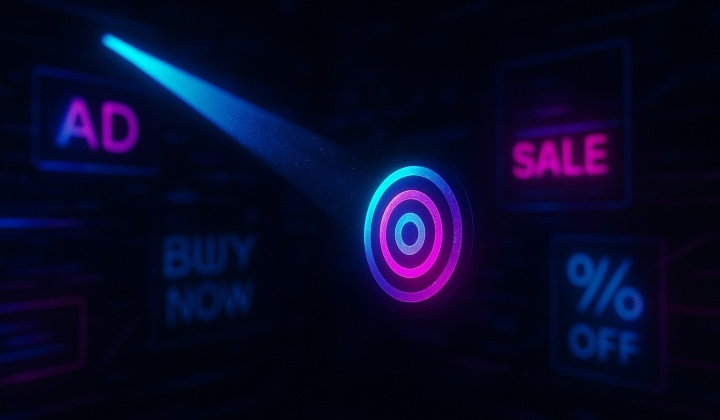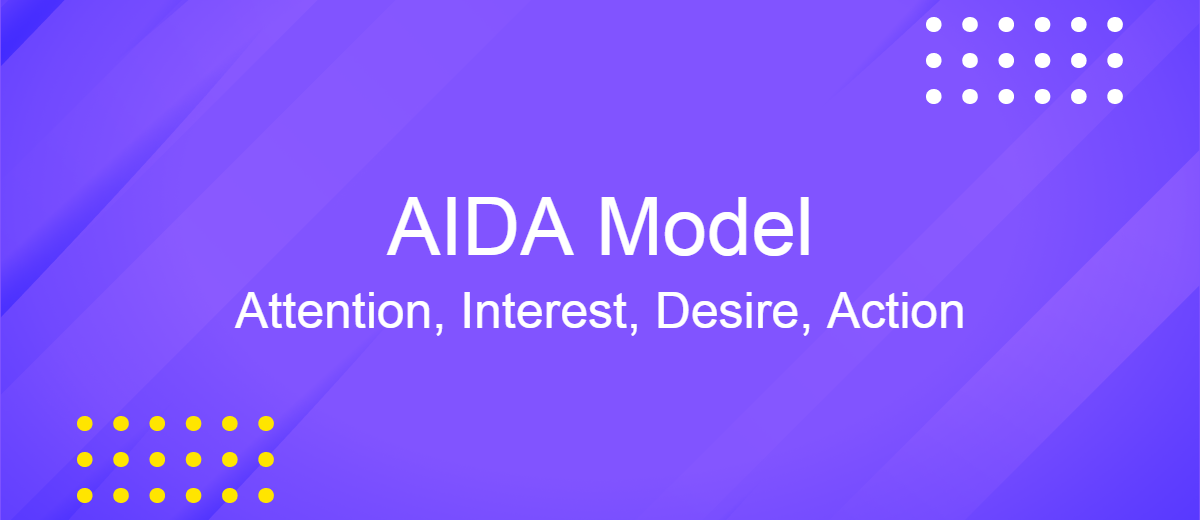Mastering the AIDA Model: How to Drive Action with Attention, Interest, and Desire
Over more than 100 years of marketing history, many concepts and frameworks have spread in this area. The most famous and universal of them is AIDA, which is one of the oldest hierarchical models—its first version was published in 1898. In this article, we will tell you what the AIDA model is and also describe in detail its components (attention, interest, desire, action) and how to apply them in marketing campaigns.
Grabbing Attention in a Noisy World
The essence of the first stage of the AIDA model is to attract the attention of the target audience. Often, instead of the word “attention,” an alternative term is used here—“awareness.” The effectiveness of the entire campaign largely depends on its result, although some marketers consider it not significant and often overlook it (since they are sure that their product or service is already known to the potential client).
However, it should be understood that the modern consumer receives dozens or even hundreds of advertising offers every day, so capturing their attention can be very difficult. Assume that most of the audience is completely unfamiliar with your brand and product, so you need to attract their attention from scratch. Successful implementation of this stage of the customer journey will help the marketer reach the maximum possible number of potential customers.
To achieve the desired result, it is important to segment the audience properly; this will help identify the target segment accurately and understand its pain points and needs. The correct choice of communication channels with potential buyers plays an important role at the first stage of the AIDA funnel.

In the case of Internet marketing, the most popular channels are:
- Content Marketing. Original, high-quality, and relevant content traditionally attracts the attention of visitors to websites, blogs, and social networks. Regular publication of interesting materials with intriguing headlines can attract a lot of targeted traffic and increase your brand awareness.
- Paid advertising. Popular advertising platforms like Google Ads are highly effective at attracting target audiences from search pages and partner sites. To successfully use this method, you should carefully segment your audience and set up targeting, as well as think through the texts and headlines of your ads.
- SEO. Search engine optimization of websites is no less effective in attracting the attention of the target audience. By improving the position of your site in natural search results, you will be able to attract many more potential customers and thus increase the conversion of promotion.
- Lead generation. Modern online marketing tools help to significantly simplify and accelerate the processes of collecting and processing target contacts from various sources: from social media to web forms. Then marketers can conduct them through the marketing funnel, receiving motivated buyers as a result.
Building Genuine Interest: From Curiosity to Engagement
After you have successfully attracted the client's attention, move on to the next stage of the AIDA model. During this stage, you need to generate interest in the audience for the offered product or service. It is important that this be not just a fleeting interest, but a sincere, sustainable involvement that will remain with the person throughout the entire communication cycle and will most likely lead to a purchase or other target action.
The second stage is considered the most difficult for a marketer, since it is possible to attract the consumer’s attention using relatively simple methods (for example, a clickbait title), but to interest them, a more subtle approach with psychological techniques is required.
If you are using the AIDA model in internet marketing, then in most cases you need to generate interest in the product after the potential client has visited the site from an advertisement or other source. To achieve effective results, provide the audience with comprehensive and meaningful information about the product, addressing their current pain points and needs.
The following tools will help you successfully engage leads:
- Description of the unique selling proposition (USP). A well-written USP will increase the effectiveness of almost any digital marketing model. Think about what qualities or characteristics distinguish your product/service from competitors' offers, and at the same time provide benefits or advantages to the target audience. Place the USP in the most visible place—the main page of a multipage site or the first screens of a landing page.
- Personalized offer. Another effective way to arouse interest in potential clients is to offer them a pleasant bonus in the form of a discount or a gift. If you want to attract several target segments, install a chatbot on your site that will automatically segment visitors and make them personalized offers.
- Lead magnet. A well-prepared lead magnet will also help to warm up the audience's interest in your product and motivate them to buy. For example, you can provide the visitor with a free checklist, guide, or other useful material in exchange for their email address or other contact information.
Turning Interest into Desire: Creating Emotional Connections
To better understand how to use AIDA, let's look into the nuances of the next stage of this framework. Let's say you managed to attract the attention and interest of potential clients, but to turn them into real buyers, you need something more—desire.
At the third stage of the marketing funnel, the consumer should have an emotional connection with the brand and its product, which will push them to order. To achieve this goal, the marketer needs to help the client realize that they really want to buy the product or service. In some cases, people may “mature” to buy at the second stage, but most often they need more time to decide.
If you want to get an emotional response from the client, you need to personalize your offer as much as possible, focusing on pain points and needs. Most often, at the third stage of the AIDA framework, marketers describe additional benefits of products (that were not included in the USP) and also “motivate” the audience with the help of personalized offers.

You can awaken the desire to buy in a website visitor using the following methods:
- Product demonstration. One of the most effective marketing techniques allows the consumer to visually see the key benefits of the product. As a result, it will help get rid of doubts and strengthen the decision to buy.
- Warming up email newsletter. Warming up your audience is very useful for transforming potential clients into real buyers. By preparing several mailing options for each of your target segments, you will be able to establish personalized communication with each of them and quickly lead them to a purchase.
- Free trial. An equally effective marketing tactic is based on consumer psychology, namely the “attraction of free.” By offering a product under the “try first, then buy” scheme, you can attract many people willing to test it. Many consumers end up choosing the free trial option, even if they were initially inclined toward alternatives.
- Discounts and bonuses. The simplest and most universal way to ignite the desire of potential clients is to offer them a pleasant discount or bonus. People perceive such marketing techniques as full-fledged gifts, which increases their loyalty and helps them make purchases more willingly.
Driving Action: Converting Desire into Results
The key and final stage of the AIDA formula in marketing helps to motivate the consumer to take a target action—purchase your product or service. In some cases, the target action is also considered to be receiving a free demo version of the product without the obligatory purchase of the full version.
The most common marketing technique for the fourth stage of the funnel is a call to action (CTA). It should finalize the information provided and evoke an emotional response in the clients, which will push them to the necessary step.
Marketers often use the final stage of the AIDA marketing model to overcome possible objections that may arise from the consumer after going through the previous stages. The following tactics also demonstrate high efficiency in Internet marketing:
- Time limit. Pop-ups with a limited-time discount or promotion (preferably with a countdown timer) motivate visitors to place an order as soon as possible, without putting it off for later.
- Early booking. This technique works for both physical and online products but is most often used when selling services (airfare, hotels, events, educational courses, etc.). To use it, place a banner or pop-up on your website offering to buy at a reduced price for a specific period of time.
The above methods can increase the value of your product or service in the minds of potential clients, create a positive impression of the product, and ultimately encourage them to close the deal.
Bottom Line
Flexibility, simplicity, versatility, and other benefits of the AIDA model have made it a legendary classic among marketing frameworks, which has remained relevant for a whole century. At the same time, it is often criticized for being too simplistic, which limits the application of this model in the complex realities of 21st-century marketing.
Nowadays, there are many variations of AIDA with modified or additional stages of the funnel. For example, these include the AIDCAS (Attention, Interest, Desire, Confidence, Action, Satisfaction), NAITDASE (Need, Attention, and Interest; Trust, Design, and Action; Satisfaction and Evaluation), or REAN (Reach, Engage, Activate, and Nurture) models. These variations are intended to improve the traditional version of AIDA, increasing its effectiveness in marketing campaigns.
Time is the most valuable resource in today's business realities. By eliminating the routine from work processes, you will get more opportunities to implement the most daring plans and ideas. Choose – you can continue to waste time, money and nerves on inefficient solutions, or you can use ApiX-Drive, automating work processes and achieving results with minimal investment of money, effort and human resources.

